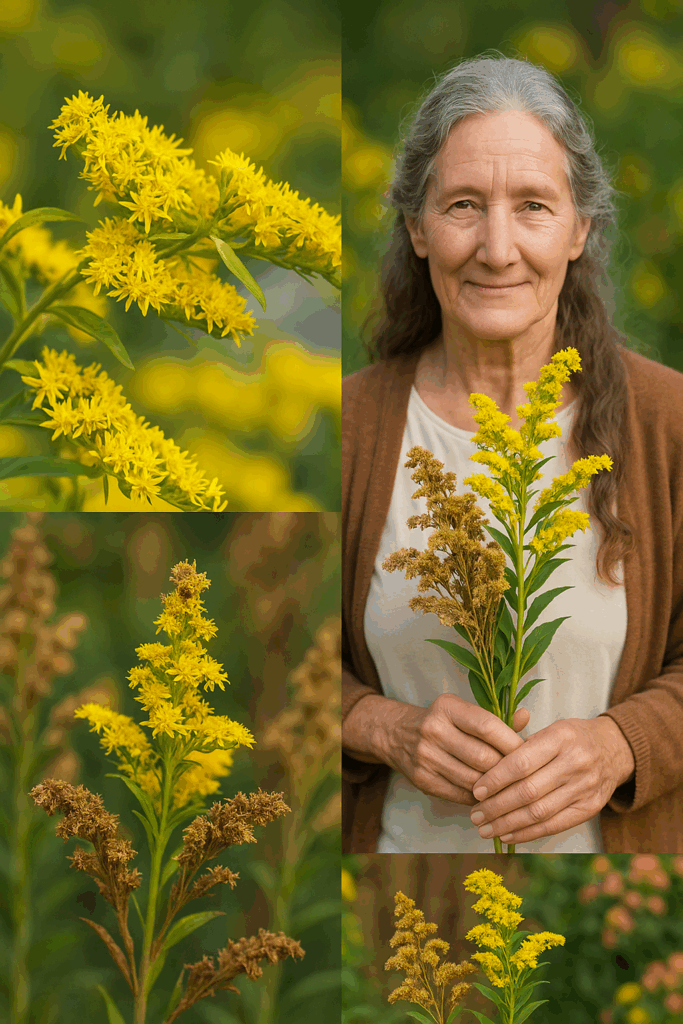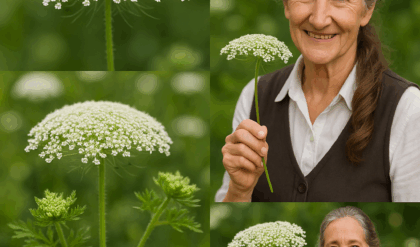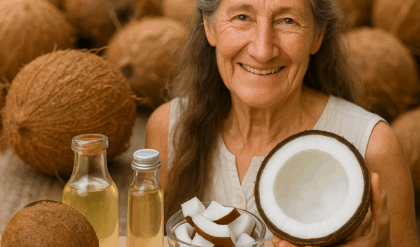Goldenrod (Solidago spp.), with its radiant yellow blooms, is far more than a late-summer spectacle. This native North American herb, often mistaken as an allergy culprit, is a cornerstone of traditional herbal medicine, prized for its anti-inflammatory, diuretic, and immune-boosting properties. From soothing kidney issues to easing seasonal sniffles, goldenrod’s leaves, flowers, and roots offer a versatile array of benefits. Whether you’re brewing a comforting tea or crafting a healing poultice, this guide explores the plant’s medicinal potential and provides practical ways to incorporate it into your wellness routine. Ready to discover why goldenrod deserves a spot in your herbal arsenal? Let’s dive into its vibrant benefits and uses.

Why Goldenrod Is a Herbal Gem
Goldenrod, often found in meadows, prairies, and roadsides, is a powerhouse of bioactive compounds like flavonoids, saponins, and phenolic acids. These contribute to its ability to reduce inflammation, support urinary health, and bolster immunity. Contrary to myths, goldenrod pollen is too heavy to cause allergies (ragweed is the real culprit), making it a safe ally for most during allergy season. Its accessibility—growing wild across North America, Europe, and Asia—makes it a sustainable choice for foragers and herbalists. By using its leaves, flowers, and roots, you can address a range of ailments naturally, all while connecting with the wisdom of traditional healing practices.
Benefits and Uses of Goldenrod Leaves
Goldenrod leaves are a go-to for kidney, respiratory, and inflammatory concerns, packed with diuretic and antimicrobial compounds.
Benefits:
- Supports Kidney Health: Acts as a natural diuretic, promoting urine flow to flush toxins and support kidney function.
- Reduces Water Retention: Eases bloating and swelling by eliminating excess fluids, ideal for edema or PMS.
- Soothes Sore Throats: Gargling or sipping leaf tea relieves throat irritation and inflammation.
- Boosts Immunity: Antioxidants and antibacterial properties help ward off infections like colds or urinary tract infections (UTIs).
- Eases Joint Pain: Anti-inflammatory compounds reduce swelling and discomfort in arthritis or gout.
- Promotes Digestive Health: Calms mild stomach upset, bloating, or indigestion.
- Fights Bacteria: Leaf extracts combat bacterial infections when used as a rinse or tea.
- Supports Respiratory Health: Loosens mucus and soothes congestion from colds or bronchitis.
How to Use Goldenrod Leaves:
- Goldenrod Leaf Tea for Kidney Health:
- Ingredients: 1 tsp dried goldenrod leaves (or 2 tsp fresh), 1 cup (240 ml) boiling water.
- Instructions: Place leaves in a cup, pour boiling water over them, and cover. Steep for 10–12 minutes, strain, and drink 1–2 cups daily to support detoxification and kidney function. Add honey for taste if desired.
- Tip: Start with one cup daily to assess tolerance, as strong diuretic effects may cause dehydration if overused.
- Herbal Compress for Joint Pain:
- Ingredients: Fresh goldenrod leaves (or rehydrated dried leaves), clean cloth.
- Instructions: Crush leaves into a paste using a mortar and pestle. Spread onto a clean cloth and apply to inflamed joints (e.g., knees, wrists). Secure with a bandage and leave on for 20–30 minutes, 1–2 times daily. Rinse skin afterward.
- Tip: Test on a small skin patch first to avoid irritation, especially for sensitive skin.
Benefits and Uses of Goldenrod Flowers
Goldenrod’s bright yellow flowers, blooming from late summer to fall, are a treasure for allergy relief, skin health, and pain management.
Benefits:
- Relieves Seasonal Allergies: Contrary to myth, goldenrod reduces allergy symptoms like sneezing, runny nose, and congestion by stabilizing histamine release.
- Anti-inflammatory Effects: Flavonoids ease inflammation, benefiting conditions like arthritis or muscle soreness.
- Eases Muscle Pain: Flower-infused oils or teas relax tense muscles and reduce post-exercise aches.
- Supports Urinary Tract Health: Diuretic and antimicrobial properties prevent and soothe UTIs.
- Rich in Antioxidants: Protects cells from free radical damage, supporting overall wellness.
- Aids Wound Healing: Topical applications disinfect and promote healing of minor cuts, scrapes, or burns.
- Improves Skin Health: Soothes eczema, rashes, or insect bites with anti-inflammatory and antiseptic effects.
- Calms Digestive Upset: Reduces bloating, cramps, or mild nausea when consumed as tea.
How to Use Goldenrod Flowers:
- Goldenrod Flower Infusion for Allergies:
- Ingredients: 1 tsp dried goldenrod flowers (or 2 tsp fresh), 1 cup (240 ml) boiling water.
- Instructions: Add flowers to a cup, pour boiling water over them, and cover. Steep for 10–15 minutes, strain, and drink 1 cup daily during allergy season (August–October). For best results, start 1–2 weeks before peak pollen season.
- Tip: Combine with nettle tea for enhanced allergy relief, but consult an herbalist for dosing.
- Flower-Infused Oil for Skin and Muscle Pain:
- Ingredients: Fresh goldenrod flowers (wilted for 24 hours to reduce moisture), olive or jojoba oil, glass jar.
- Instructions: Fill a clean jar halfway with wilted flowers, cover with oil, and seal. Place in a warm spot (e.g., a sunny windowsill) for 2–3 weeks, shaking daily. Strain through cheesecloth into a clean bottle. Apply to sore muscles, irritated skin, or minor wounds 1–2 times daily.
- Tip: Store oil in a dark bottle in a cool place; use within 6 months for maximum potency.
Benefits and Uses of Goldenrod Roots
Goldenrod roots, though less commonly used, are a potent remedy for bladder health, detoxification, and nerve pain.
Benefits:
- Supports Bladder Health: Strengthens bladder muscles and reduces urgency or incontinence, especially in older adults.
- Reduces Inflammation: Eases systemic inflammation, supporting conditions like sciatica or fibromyalgia.
- Boosts Circulation: Improves blood flow, aiding cardiovascular health and reducing leg swelling.
- Aids Detoxification: Enhances liver and kidney function to flush toxins from the body.
- Soothes Nerve Pain: Traditionally used for neuralgia, sciatica, or other nerve-related discomfort.
How to Use Goldenrod Roots:
- Goldenrod Root Decoction for Detoxification:
- Ingredients: 1 tsp chopped dried goldenrod root (or 2 tsp fresh), 2 cups (480 ml) water.
- Instructions: Add root to a pot with water, bring to a boil, then simmer for 20–25 minutes until reduced by half. Strain and drink 1/2 cup once daily to support detox and circulation. Refrigerate leftovers and use within 24 hours.
- Tip: Roots are tougher, so a longer simmer extracts more compounds. Avoid overuse to prevent digestive upset.
- Root Poultice for Nerve Pain:
- Ingredients: Fresh goldenrod root (or rehydrated dried root), clean cloth.
- Instructions: Mash root into a paste with a mortar and pestle (add a splash of warm water if needed). Apply to areas with nerve pain (e.g., lower back for sciatica), cover with a cloth, and leave on for 30 minutes. Rinse skin and repeat 1–2 times daily.
- Tip: Combine with a warm compress for deeper relief, but monitor skin for irritation.
Harvesting and Preparation Tips
To maximize goldenrod’s benefits, proper harvesting and preparation are key:
- When to Harvest:
- Leaves: Late spring to early summer, when young and vibrant.
- Flowers: Late summer to early fall (August–September), when fully open but not fading.
- Roots: Late fall after the plant dies back, when energy is stored underground.
- Where: Collect from clean, pesticide-free areas like meadows or gardens. Avoid roadsides or industrial zones.
- How: Use clean scissors to snip leaves and flowers; dig roots carefully with a trowel, taking only what you need to preserve the plant.
- Drying: Spread leaves, flowers, or chopped roots on a drying rack in a shaded, well-ventilated area. Dry until crisp (5–10 days), then store in airtight glass jars in a cool, dark place. Shelf life: 1 year for leaves/flowers, 2 years for roots.
- Sustainability: Harvest no more than 20–30% of a plant population to support regrowth and pollinators like bees, which rely on goldenrod’s nectar.

Safety Precautions
Goldenrod is generally safe but requires caution:
- Allergies: Though rare, some may be sensitive. Test teas or topical preparations on a small skin patch or sip a diluted tea first. Discontinue if rash, itching, or digestive upset occurs.
- Medication Interactions: Goldenrod’s diuretic effects may interact with diuretics, blood pressure medications, or lithium. Consult a doctor if on these drugs.
- Medical Conditions: Avoid if you have kidney disease, heart conditions, or edema due to heart failure, as diuretics can worsen symptoms. Pregnant or breastfeeding individuals should consult a healthcare provider.
- Moderation: Limit tea to 1–2 cups daily and decoctions to 1/2 cup to avoid dehydration or electrolyte imbalance from diuretic effects.
- Identification: Ensure you’re harvesting true goldenrod (Solidago spp.), as some lookalikes (e.g., ragweed) may cause allergies or toxicity. Consult a field guide or botanist if unsure.
Why Goldenrod Matters
Goldenrod is a testament to nature’s ability to heal and nurture. Its leaves, flowers, and roots offer a holistic approach to wellness, addressing everything from kidney health to allergy relief with minimal cost. Foraging or growing goldenrod connects you to the land, fostering mindfulness and sustainability. In a world of synthetic remedies, this plant reminds us of the power of simple, time-tested solutions. Whether you’re sipping a goldenrod tea to ease a cold or massaging flower oil into sore muscles, you’re tapping into centuries of herbal wisdom.
Disclaimer: This information is for educational purposes only and not a substitute for medical advice. Consult a healthcare professional before using goldenrod, especially if you have medical conditions, are pregnant, or take medications. Improper use may cause side effects like dehydration or allergic reactions. Always verify plant identification to avoid toxic lookalikes.
Start Your Goldenrod Journey Today
Goldenrod’s golden blooms are calling—ready to explore its healing potential? Next time you spot this vibrant plant in a field or garden, harvest its leaves, flowers, or roots with care and transform them into powerful remedies. From kidney-cleansing teas to allergy-soothing infusions, goldenrod is your gateway to natural wellness. Share this guide with friends and fellow herbal enthusiasts, and let Solidago light up your health routine with its sunny, healing glow—begin today!





